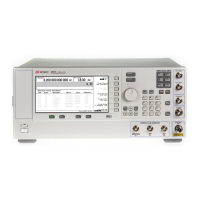E8257D/67D, E8663D PSG Signal Generators Service Guide
Troubleshooting
Troubleshooting Assembly–Level Problems
1-52
2. Turn the RF power on and verify the presence of an RF signal on the output.
• If no RF signal is present, troubleshoot the RF path problem (see “Troubleshooting the RF Path” on page 1- 75).
3. If an RF signal is present on the RF output, set the signal generator to 4 GHz and 0 dBm.
4. Measure the dc voltage on the cable going to J3 of the A10 ALC. The signal should be approximately –0.3 Vdc.
• If the signal at J3 is good, go to step 6.
5. If no dc signal is present on the cable to J3, check the output at the highband detector.
• If the signal is good at the detector, replace the cable.
• If no signal is present at the output of the highband detector, replace the highband detector.
6. If the signal at J3 is good, set the signal generator’s frequency to <1 GHz, the power to 0 dBm, and measure the
dc voltage on the cable going to J5 on the A10 ALC.
• If the dc voltage is approximately –2.2 Vdc, replace the A10 ALC.
7. If other dc voltages are present, check for dc voltage on the output of the lowband detector.
• If a dc voltage is present, replace the cable.
• If no dc voltage is present, replace the lowband detector.
1205 LB Pulse Mod
Lowband Pulse On
1. Disconnect the cable from J5 of the A10 ALC, and connect the cable to a DVM (this is the lowband detector
output).
2. On the signal generator, set the following:
Center Frequency: 3 GHz
Power: +20 dBm
Pulse Modulation: On
Period: 40s
Pulse Width: 10 ns
RF: On
3. The voltage measured by the DVM should be approximately 0V. If it is not, use an oscilloscope to view P131–6 of
the A31 Motherboard (this is the pulse signal out of the A11 Pulse/Analog Modulation Generator).
Change the pulse period to 1 ms and the pulse width to 500 μs.
• If the pulse is not present, perform the A11 Pulse/Analog Modulation Generator self–test, and follow the
troubleshooting procedure.
4. If pulse modulation is working, perform the A8 Output self–test.
• If the self–test passes, refer to “Troubleshooting the RF Path” on page 1- 75, and check the lowband path.
• If the self–test fails, refer to the A8 Output test troubleshooting.
Lowband Pulse Off
1. Disconnect the cable from J5 of the A10 ALC, and connect the cable to a DVM (this is the lowband detector
output).
2. On the signal generator, set the following:
Center Frequency: 3 GHz
Power: +20 dBm
Pulse Modulation: On
Period: 40s
Pulse Width: 39.9s
RF: On
3. The voltage measured by the DVM should be approximately −1.8 V. If it is not, use an oscilloscope to view P131–6
of the A31 Motherboard (this is the pulse signal out of the A11 Pulse/Analog Modulation Generator).
Change the pulse period to 1 ms and the pulse width to 500 μs.

